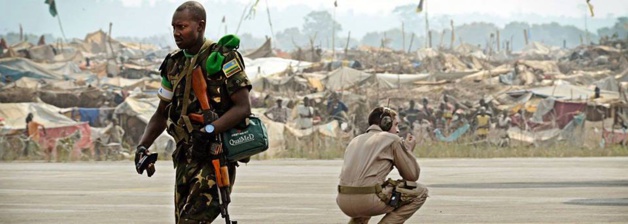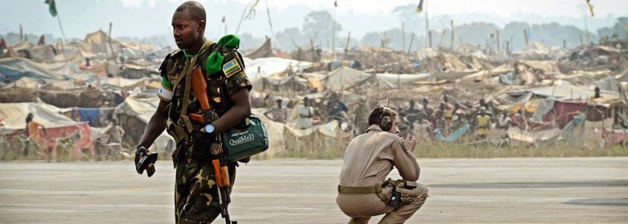
Credits RR
At the very start of the year 2013, everything turned upside down when the forces of the Séléka “alliance”, a coalition composed of political parties and armed groups (mostly Muslim), overthrew the President François Bozizé, after wreaking havoc across the North-East of the country. From December 2012, the President had called on his “French cousins and the United States of America” for help fighting against the rebels. At that time, there were more than 1200 French nationals in the Central African Republic, but France ruled out any intervention. On March 24th, rebels placed Michel Djotodia at the head of the State: he was the first Muslim Head of State in the Central African Republic. Then, the country immediately escalated into violence. Séléka spread terror and death in the Christian villages, causing tens of thousands of deaths in the civilian population.
From interfaith violence to ethnic cleansing
Suffering from the violence of Séléka, the Christians of the Central African Republic developed a strong hatred against all Muslims. Right after the dismantling of Séléka in September 2013, the former self-defense militias with a Christian majority, called Anti-balaka or « anti-machete », took up arms to avenge themselves from the violence committed by Séléka. Thereafter, members of the Anti-balaka Christian militias attacked the Muslim community indiscriminately, spreading death among women and children, as well as former members of Séléka. Considering that the Muslim community constitutes a minority in the Central African Republic, the United Nations and Amnesty International evoked and condemned a real “ethnic cleansing”.
Michel Djotodia resigned in January 2014. His replacement at the head of the State by a transitional President of Christian faith, Catherine Samba Panza (mayor of Bangui), changed nothing with regards to the situation: members of Anti-balaka still slaughter Muslims, while the former Séléka withdraws toward the North, razing Christian villages to the ground in its way. Even inside the capital, violence rages. Mosques are set on fire, books are destroyed, and Christians are burnt alive in churches, as in Notre-Dame de Fatima in Bangui, in May 2014. Meanwhile, thousands of people try to leave the country, to find shelter among their neighbors in Central Africa… In total, almost 200 000 people have left the Central African Republic territory since the beginning of the conflict. Among those who stayed, 100 000 are crammed in an improvised refugee camp at the airport of the capital, feeling safer there. Or at least more able to flee quickly if the Anti-balaka attack.
An ineffective presence
From the start of the crisis, in December 2012, the African Union and the United Nations guided the formation of the African-led International Support Mission to the Central African Republic (MISCA, from the French acronym). Around 6000 men from the armed forces of the neighboring countries were spread on the territory. However, this international Mission is ineffective and underequipped. Worse still, the very population it is supposed to protect views it unfavorably. The reason is obvious: on March 29th, in Bangui, no less than twenty-four civilians were killed by the Chadian contingent of the MISCA, who has since withdrawn. This insecurity can only unsettle the humanitarian organizations that try to answer this humanitarian crisis. As a testimony, numerous official statements from “Médecins Sans Frontières" (Doctors Without Borders) denounced the multiplication of kidnappings, rackets and thefts of medical material. This represents many obstacles to the good progress of these essential humanitarian missions.
Even the presence of French troops, which have never left the country since the independence, had no effect: 200 servicemen were stationed in Bangui during the coup of Séléka in March 2013. They were powerless. Likewise, soldiers of the troops sent by the European Union in January 2014 have not affected the operations of Anti-balaka since. The arms embargo declared by the United Nations could not reduce the arrival of weapons on the territory.
The end of the conflict is still not in sight
The month of July 2014 provided a glimmer of hope concerning the conflict resolution. On July 21st, in Brazzaville, a peace agreement, or at least a ceasefire agreement, was signed by representatives of Séléka and Anti-balaka. Both militias had agreed to sign a treaty on the end of exactions and the restoring of free circulation for the populations in the different regions of the country. However, they did not mention the question of disarmament. This agreement was threatened as soon as it was signed, which angered the most extreme members of both camps. Moreover, it did not prove to be of the utmost efficiency for calming the conflict…
During January 2015, representatives of Séléka and Anti-balaka worked on the writing of a new treaty, to the great displeasure of the transitional authorities. It was signed on January 27th in Nairobi. In order to impulse a peace process - this time for good -, the agreement included a specific point on disarmament, thus obeying to the DDR mechanism (Disarmament, Demobilisation and Reintegration). It planned to reintegrate the combatants from both camps into the Central African regular army, after a rigorous selection. With this treaty, the signatories also militated for a replacement of the transitional authorities.
Not only did the Nairobi agreements fail to build consensus inside the two opposite movements: the Economic Community of Central African States rejected them a few days later, considering them unfit to bring back peace in the Central African Republic. To date, the Central African conflict is yet to find a stable, long-lasting solution. In the meantime, the kidnappings of politicians and foreigner engaged in humanitarian aid have multiplied since the beginning of the year, and French forces are progressively withdrawing.




























